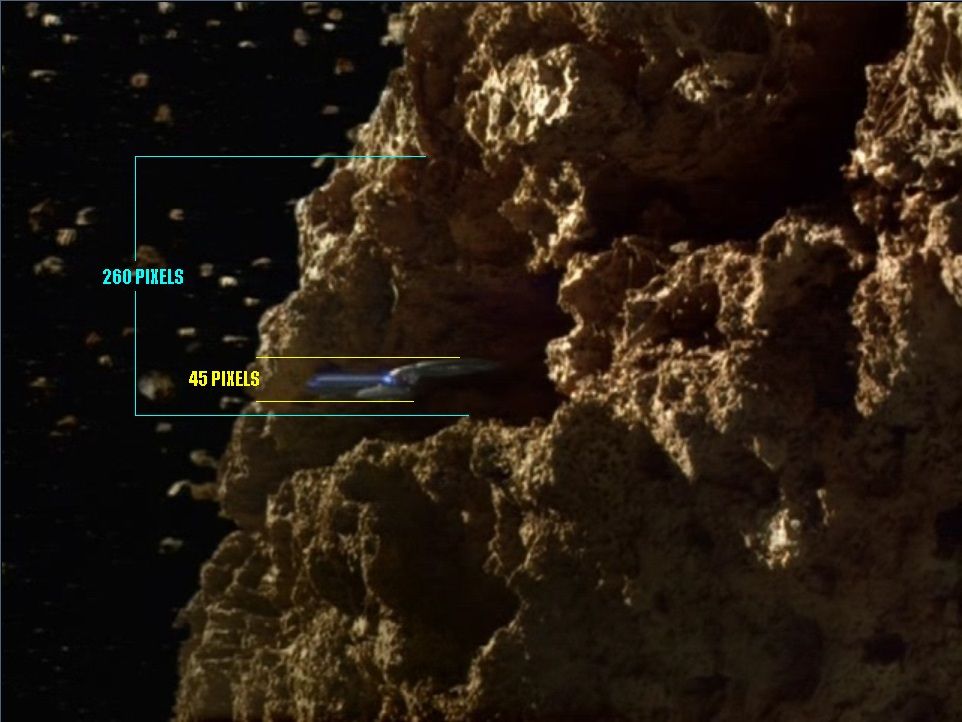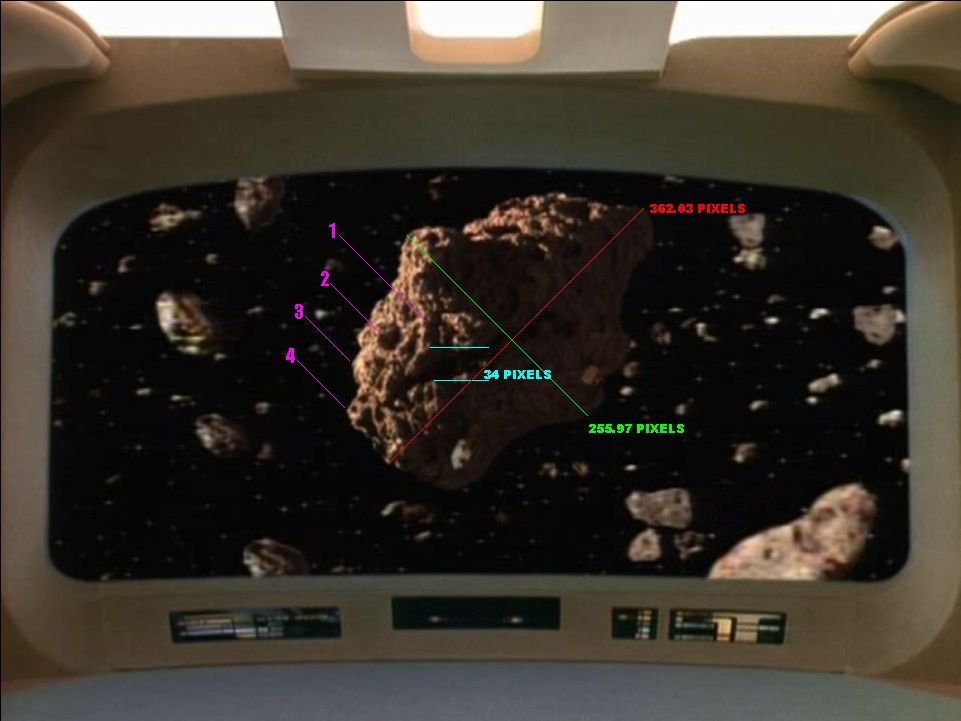Mr. Oragahn wrote:I can't remember what AMOT is about, but I know for sure that Masks certainly does not point to high figures. Much on the contrary.
"A Matter of Time" involves drilling for carbon dioxide pockets. It's most famous for the .06 terawatt maximum variance, and the threat to accidentally burn off the planet's atmosphere.
It certainly does.
For every cubic kilometer of typical comet-density snowball (.5 g/cc) that is turned into dissipating vapor, you have to come up with 600-700
megatons of energy. If you're superheating it - one possible explanation for the luminous yellow effect in the melt zone and the swift dissipation of gases - that can nearly double.
We have an initial state, we have a final state. The scaling of the comet is disputed, but regardless of which scaling you use, we have a multi-gigaton event.
Other phaser drilling events are hard to gauge because we don't know for fact if it requires 10 joules of energy to make dissapear a given amount of rock that would get vapourized with 10 joules of energy.
Pegasus is very open ended, but certainly does not even approaches the craziest stuff of TOS.
Does it?
This asteroid looks to be larger and more massive than the ones destroyed by the Romulans in "Balance of Terror." It possibly even exceeds the volume of rock melted by the
Enterprise's maximum strength phaser blast in "The Paradise Syndrome," and I suspect there's going to be a higher energy density involved in the putative "Pegasus" incident.
In fact, the "blast out of the asteroid using phasers" plan involves quite a bit of firepower too. We're dealing with on the order of a cubic kilometer of rock here.
The whole visual is illogical. You say it's hard to argue for sub gigaton, solely based on the size of that flash. But it's equally hard to argue for such yields based on the duration of that flash.
Besides, didn't they land again and check out what happened?
As I said, it's a bloom, not a flash...
but I also modeled it as a flash of light. Same results.
Guess what? Solar intensity illumination at a 187.5 km radius means your source is putting out 4*pi*(187,500m)^2*1.4 kW/m^2 = 620 terawatts of radiation in the visible range. Overall, we see about a petajoule of luminous energy right there. And what percentage of the energy of a matter/antimatter weapon is going to go out in the visible spectrum in two seconds?
Well, in general, based on what we know about M/AM reactions and nuclear tests within atmosphere... initial visual flash is going to be a pretty small fraction of the yield. Maybe 0.1% if you're lucky. Whoops. We went over a gigaton,
again.
Of course, there's a little bit of flex in those figures, but not much. I went over this a lot at ST.com in horrific detail. No matter what physical phenomenon you model that little beige circular thing as, barring unreasonable assumptions (such as assuming the planet is nowhere near Earth-sized) wind up in the general neighborhood of e18-e19 joules based on the scale and speed of effect.
I'm curious about how you obtain those figures though. I'd probably pick the figures on your website with a much more open heart if I had no checked Masks to see that your gigaton phaser estimation was a pure invention which is heavily contradicted by the very episode, when watched, not seen through one or two screencaps.
Pure invention? Hardly.
Prone to error? Yes. "Masks" is
not a very precise incident. It's also a 10% power incident, and my final conclusion (on my website) is that a short burst with about a gigaton yield should be possible is one that's quite far away from the high end of the range dictated by the MOE.
That works out to taking about 6-7 seconds
per cubic kilometer of comet.
Besides, the point is making the averages when there are great variances. TNG+ has many references, and you can find a middle ground with eventually top petawatt ranges from warp core, a percentage of that being diverted to phasers, and two digits, maybe three digits for torps; although again in theory a low gigaton torp should be no problem there.
The problem is what kind of average I take. If I take the arithmetic mean, then if I count Spock's claim to be able to
split in two pieces something half the size of the moon, and divide by a hundred cases in which little is done, then I'm still in the multi-gigaton range - and it's a very weak example to start with, especially since the phasers don't have that huge of an effect.
The real problem to be how Gene Rodenberry has retconned certain aspects of Trek. The most obvious recton being the flight speeds.
I don't believe he actually retconned those. The TOS "backstage" scale is one of the slowest scales available, and had nothing to do with actual TOS speeds. Likewise with TNG.
Eventually, that ounce of antimatter thing could be rationalized if we really pushed it hard, by implying volume, a high concentration, checking out what 10,000 cobalt bombs means in that context, and that the atmosphere itself only needed a something to start going through an exotic chain reaction.
Still, there's that sound wave of jaw dropping power, where rationalization is harder.
And the matter of how much atmosphere the planet has, how large the planet is... et cetera. I'm inclined to treat that one as a simple scientific error, personally.
But as a whole, the pattern is that for TOS, rationalization is used to lower figures, while in most of TNG and late Trek, it's used to increase them.
Er... not really. As a rule, I rationalize far fewer examples than I discard. I mostly take figures, discard all the ones that I can't fit to within a generous MOE, and then run with what seems reasonable from there in making my final estimate. I also consider the relative strength of the example. SOE is quite strong as a "lower bound" type estimate, but it is not very precise.
I have chosen a gigaton as a probable maximum torpedo yield not based on the maximum possible yield seen in effects. A reasonable estimation for every firepower example includes a number of ranges that go well past the gigaton mark when considered carefully - but the amount of antimatter stored on a torpedo seems sharply limited.
TDIC I choose to discard when analyzing firepower. The order of magnitude of firepower required to physically disassemble a planet is simply not compatible with the other cases. Similar with STV. That sheer speed and range is very difficult to reconcile with most later examples.
"Where Silence Has Lease" gives one of the highest speeds of any episode... and it's for
warp 2. I prefer to place that one in the outlier column as well, though I may consider it when picking my median path.
You call them problematic, I suppose, in the context where someone would like to make all yields worth of the TOS craze.
Like I said, there really aren't more low-yield than high-yield examples in the TNG+ era. TDIC is the singular most egregious example, but some of the most high-energy events happen in Voyager and DS9. I pointed out just how much more lethal the Delta Flyer's projected warp core breach is than the detonation of Dreadnought's warhead.
Huh, from what I've read, TOS enabled speeds which had ships cross a galactic radius in less than a day.
OK, please read
this page. While there are a number of examples that seem pretty loose, every incident in which the old Constitution-class Enterprise definitely travels 30,000 or more light years within one day involves hijacking. All but STV involve highly advanced aliens. As I've said, STV should be discarded as an outlier. Speeds in TOS under conventional warp power in general do not exceed 1 million times lightspeed, although they sometimes come close, and usually are not sustained for more than a couple thousand light years at a stretch.
As a whole, TNG+ really got below that.
Below
and above.
TNG has the second-fastest top speeds (next to STV) and the largest volumes of inanimate matter destroyed by Federation phasers, and comes a close second to "Generations" for most destructive use of weapons by a Federation-level character (solar destruction). TNG also
requires higher reactor power than any other series, as mentioned previously.
DS9 has the singularly highest actually used bombardment firepower example,
hands down, in TDIC. Planets only ever blew up on their
own in TOS. Or got eaten by a certain ancient alien superweapon that the Federation couldn't possibly duplicate, but even the alien superweapons got bigger. Supernovas as collateral damage for the Q, anybody?
Voyager explicitly gives the highest hazard-to-mass ratio for a vessel with the Delta Flyer in "Drive." Do you know how many
teratons you need to destroy all light vessels within a million klicks? Just killing unprotected humans at that distance is difficult.
But, in the end, maybe Trek on the average can have yields tickling the gigaton range without any problem.
If you really want to see if this reality works better than the more moderate ones argued by other people, you could still try to talk to a debator from SDN, or SBC, and actually defend that position.
Maybe you (JMS) could get some decade old misconceptions corrected, and possibly increase the averages.
So, what do you say? This would surely revive the debate.
I've talked with some SDN/SB residents of the anti-Trek persuasion on ST.com. Mostly, they don't seem to listen to the evidence regarding any high power or high speed example, preferring to try to rationalize it away in various irrational ways.
If you want a true average, I could throw them all together and average, but I'd probably wind up with something unreasonably high thanks to the occasional truly ridiculous example.


